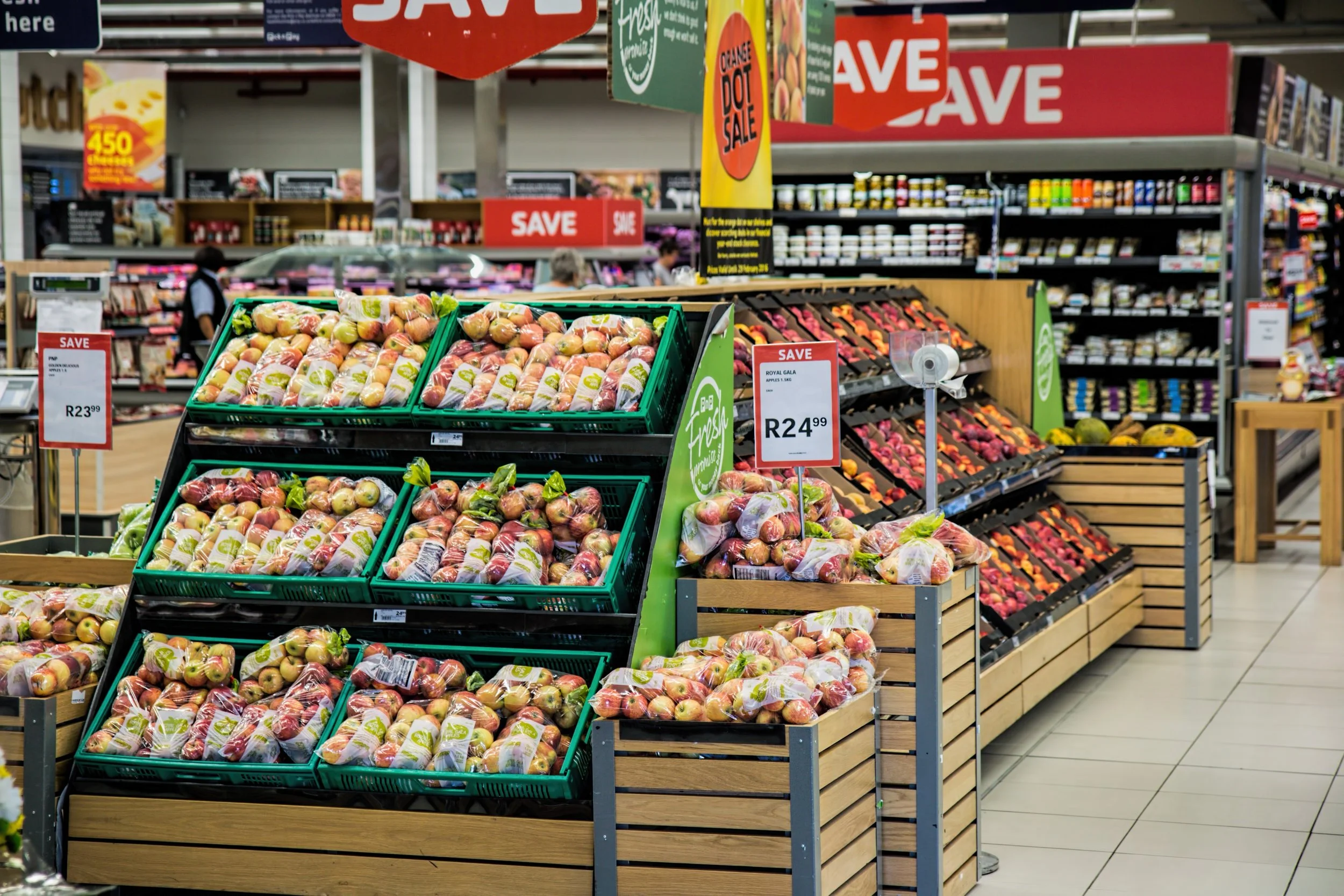Shopping as a College Student: Breaking Down a Stop & Shop at The Grocery Store
By Ian Buske
Fall 2022

Let’s face it—any kind of shopping in college sucks. It’s not the most appealing thing in the world considering the constant battle against your bank account balance. Grocery shopping especially sucks because it’s usually been the parents’ responsibility. Keeping an extra stash of food on-hand is a must—especially with the college student’s reality of life. The frantic schedules and sub-par dining hall food make even more reason to keep extra food on hand. College students deserve to be better informed when making a trip to the grocery store. This will be a breakdown of a productive grocery store trip for college students to use as a reference.
Come up with a Specific Plan
Arguably, the most important aspect of making a trip to the grocery store is creating a plan. It was stated during an interview with a store manager at Jewel-Osco, Pam Sherwood, “Having a plan before going in [to shop] is quintessential to having a successful trip. Shopping without a plan is usually good for us, but not necessarily for yourself.” You won’t get very far without a plan, or you’ll end up with items that you didn’t need.
Set a Goal
Any trip to the grocery store is incomplete without a list of items needed. Whether short or long, a list is going to be the guiding influence for what needs to be accomplished. However, this task is likely easier-said-than-done for a college student who might have little to zero experience doing so. The goal of a grocery list is not just to have a certain number of items that need to be purchased. According to Dr. Samantha Fecich with Best Colleges, it can help with budgeting, meal prep, and making healthy meal choices. This type of organization strategy will create easy and achievable goals for each trip to the store.
Assess Your Budget
As emphasized before, money is at an all-time premium for a college student. Therefore, a budget is going to be a driving force in the decision-making process. The Cleveland Clinic recorded 10 tips for shopping on a budget:
Shop for nonperishable items online
Buy perishable foods in quantities you’ll use
Buy fresh fruits and vegetables in season
Buy meat and cereals in bulk
Be an informed shopper – pay attention to the weekly ads & direct mail
Limit your purchase of ready-prepared foods – usually more expensive and not as natural
Clip coupons with caution – may persuade you to buy items you don’t necessarily need
Use your imagination with leftovers – create soups, casseroles, and other new dishes to avoid waste
Look for outlet stores such as day-old bakeries
Avoid portion-controlled snack packs
Following these tips aren’t necessary to each trip to the store, but they serve as great references for when budgeting becomes more important one time or another. They also act as great supplements to add into your list/plan. It’s easy to grab the cereal that looks the best, but it might be a wise decision to have a note reminding you to search for the cheapest option.
Shop for Nutrition
Keeping a proper nutrition in college is quite an overlooked topic. Your health metabolism is usually peak during this time, so eating healthy might be lower in the list of priorities. However, making healthy choices this time in life can help establish healthy habits for the rest of your life. Sometimes this is difficult to achieve with a dining hall lacking enough nutrients for a proper meal.
Sarah Katz with Georgia State University offered up a few tips to aid nutrition which included meal planning, building a colorful cart, read food labels, stock up on canned foods, and avoid shopping hungry. While this doesn’t spell out the correct plan to follow, it can indirectly aid in keeping a healthy pantry.
Making healthy choices this time in life can help establish healthy habits for the rest of your life. Sometimes this is difficult to achieve with a dining hall lacking enough nutrients for a proper meal.
What To Look For
With all the preparation taken care of, now it’s showtime. The trip itself is naturally the most important part of this sequence. A lot goes into the grocery store experience—whether you notice it or not.
Store Layout
A grocery store is extremely intentional with how their store is arranged. This starts with each department, and it goes down all the way to where products are placed on the shelf. A video done by upnextLAB, a design thinking YouTube channel, they explain that flowers and produce are usually placed at the front of grocery stores which conveys a message of selling fresh products. This type of strategy allows stores to build a sense of trust with their consumers. In this same video, it’s explained that the bakery, deli, dairy, pharmacy, and other such departments are located towards the outside of the store. This creates the need to travel across the entire store to be exposed to the greatest number of products possible.
Shelf Layout
On a smaller scale, the shelf layout is just as important as the layout of the store. In a video done by the New York Times, Michael Pollan and Michael Moss remark, “Behind the shelf is the most fiercely competitive industry there is”.Behind the scenes, companies are constantly at odds over their spot on the shelf. Hiranmayi Srinivasan with Real Simple explains each tier of shelving’s intention. The top shelf is usually home to smaller, regional, and gourmet brands to help set the tone. The second and third shelves (known as the “bull’s eye zone”) is going to be the most expensive placement from a brand’s perspective. These products usually have the highest sales or markups. Products directed towards kids will take their place in the lower shelves due to the lower eye-level. Lastly, the bottom shelf usually contains store brands or bulk products—more practical use than anything.
Eye Candy
The classic move groceries stores pull here is placing snacks, candy, and magazines by the register with the hopes that customers will purchase these products off impulse. However, there is a lot more visual detail effort placed into the store aside from this. Krystyna Huang, a manager at Mariano’s grocery store pointed out, “Our stores convey the image of quality from the front of the building to the very choice of martial we use for our displays”. Every grocery store puts forth effort to make customers feel a certain way. These feelings help reinforce consumers purchase decisions. As a college student, be sure to recognize these differences to set some expectations for a prospective next visit.
Labels
Diving even deeper is the information wrapping the products themselves. Investigating a product’s contents can help you justify purchase decisions. Registered Dietician, Tracy Lockwood-Beckerman, explains in a video from Well+Good that above all, protein, fat, and sugar content should be the biggest figures to look at. College students should target low sugar products and value items high in protein. The idea is to keep you full longer and sustain higher energy levels. Not everyone will always read the labels, but it never hurts to do so.
Stick to the Plan
To finish off the in-store experience, make sure you stick to the plan that you set in place to begin with. Executing a grocery store as planned is crucial for a college student. This keeps your budget easy, mind clear, and pantry full.
Evaluate
The final step to the grocery store trip is to see how you did. Often this includes double-checking to make sure you retrieved the items you set out to grab. Other times it could be a regret for an impulse purchase. Eliminating the desire for impulse purchases can be difficult. In a study by Rice Business, reflection is one of the most effective ways for anti-consumption. A reflective thought process often used to help redirect the impulse desire to purchase a product. For example, if you have an urge to buy a pint of ice cream but realize you already have chocolate protein muffins at home helps rationalize the restriction to purchase.
Make Note of Unused Product
Another good practice is keeping track of product-gone-bad. This should help eliminate any unnecessary purchases or motivate you to finish the product you bought next time. In an article from Supermarket News, the Associated Press designated that “best before” has nothing to do with food safety, while “use by” is more pertinent to perishable items. Food distinctions should be ideally made while in the store, but definitely take note of these distinctions at the very least when you unload your groceries. Taking a simple note down to remind you of these details can result in money saved.
Keep the Receipts
The last part of a grocery store trip is when the receipt pops out of the printer. While it might seem gratuitous, that small piece of paper can contribute a great deal to the standing of your online bank statement. A good idea might be starting an excel sheet with all of your grocery purchases to help with organizing your financials and to keep track of items that have worked well or not-so well. US News explains the use of receipt scanner apps that help with organization and getting cash back at select stores. This resource sounds like the perfect idea for a college student to utilize. Most of the apps seem easy-to-use, and they give you free money back. If anything, this should help with planning for the next trip.
Conclusion
With all these tools at your disposal, we hope that you can improve your trips to the grocery store when that dining hall food just isn’t cutting it. Being able to gauge what you need and what to make with the food you have is a skill that develops with time. Understand that it won’t be perfect every time, but there are things that can be done to make the stops to the store more efficient.
Ian Buske is a Senior student at North Central College in Naperville, Illinois. He is studying Sport Management and Marketing. He participates on the Cross Country and Track & Field teams. Ian grew up in suburban Des Moines, Iowa where he loved being around sports all the time. He currently works for Naperville Running Company and has worked for a few different retailers in the past. Ian has also worked for three different sports teams (Iowa Cubs, Chicago Sky, and Chicago Dogs). His favorite teams are the Chicago Bears, Cubs, Iowa Hawkeyes, and Auburn Tigers. Ian enjoys watching sports, golfing, hanging out with friends, and watching movies in his free time.


